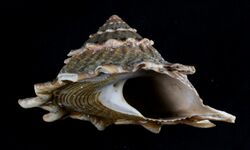Biology:Pomaulax japonicus
From HandWiki
Revision as of 14:07, 10 August 2022 by imported>CodeMe (fixing)
Short description: Species of gastropod
| Pomaulax japonicus | |
|---|---|

| |
| Shell of Pomaulax japonicus (Dunker, 1844), measuring 47.7 mm in height by 74.8 mm diameter, collected with tangle nets at 20 m depth off Pt. Daio, Shima-cho, in Japan . | |
| Scientific classification | |
| Domain: | Eukaryota |
| Kingdom: | Animalia |
| Phylum: | Mollusca |
| Class: | Gastropoda |
| Subclass: | Vetigastropoda |
| Order: | Trochida |
| Superfamily: | Trochoidea |
| Family: | Turbinidae |
| Genus: | Pomaulax |
| Species: | P. japonicus
|
| Binomial name | |
| Pomaulax japonicus (Dunker, 1844)
| |
| Synonyms[1] | |
| |
Pomaulax japonicus, the Japanese star shell, is a species of sea snail, a marine gastropod mollusk in the family Turbinidae, the turban snails.[1]
Description
The size of the shell attains 90 mm. The large, imperforate shell has a depressed-conic shape. It is pale yellowish. The six whorls are planulate above, and obliquely tuberculate-plicate. The periphery is expanded, compressed, carinated, bearing wide nodose spines. The base of the shell is planulate, with concentric tuberculate lirae. The white umbilical tract is, callous and depressed. The aperture is transversely dilated, subrhomboidal, and angulate.[2]
Distribution
This marine species occurs off Japan and Korea.
References
- ↑ 1.0 1.1 Pomaulax japonicus (Dunker, 1844). Retrieved through: World Register of Marine Species on 27 September 2012.
- ↑ G.W. Tryon (1888), Manual of Conchology X; Academy of Natural Sciences, Philadelphia (described as Astralium japonicum)
- Alf A. & Kreipl K. (2011) The family Turbinidae. Subfamilies Turbininae Rafinesque, 1815 and Prisogasterinae Hickman & McLean, 1990. In: G.T. Poppe & K. Groh (eds), A Conchological Iconography. Hackenheim: Conchbooks. pp. 1–82, pls 104–245.
External links
- "Pomaulax japonicus" (in en). Gastropods.com. http://www.gastropods.com/8/Shell_2468.shtml.
Wikidata ☰ Q7227236 entry
 |

